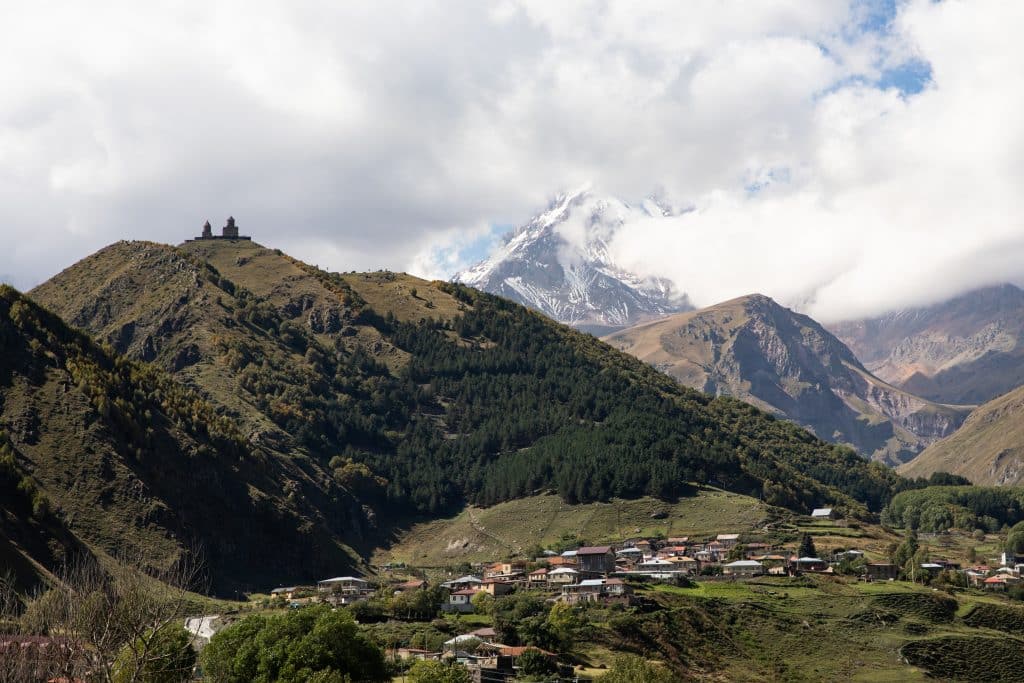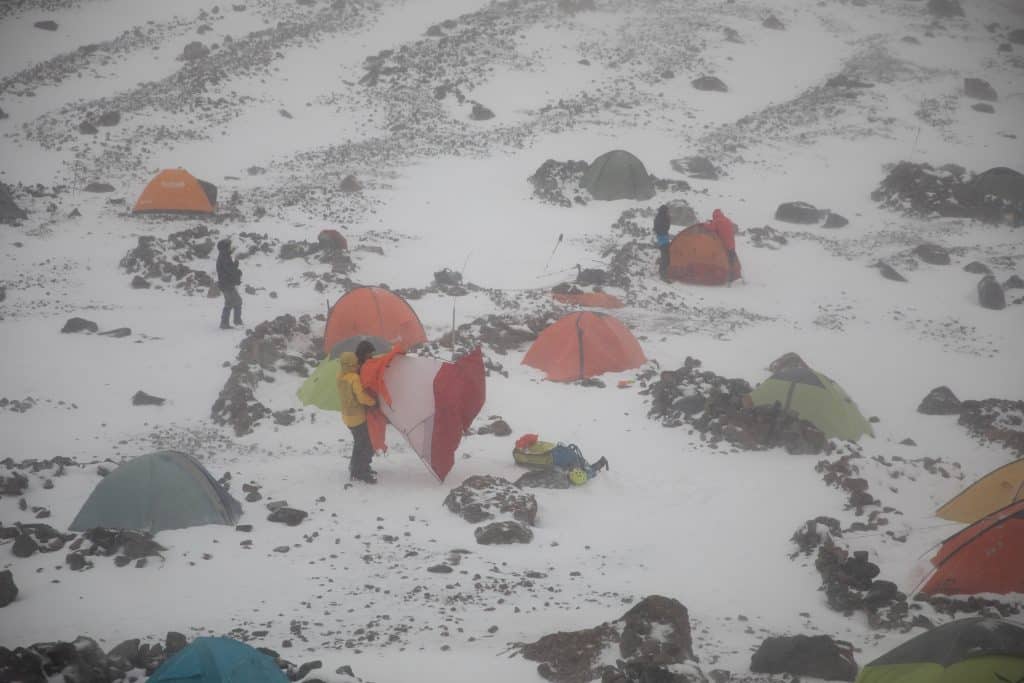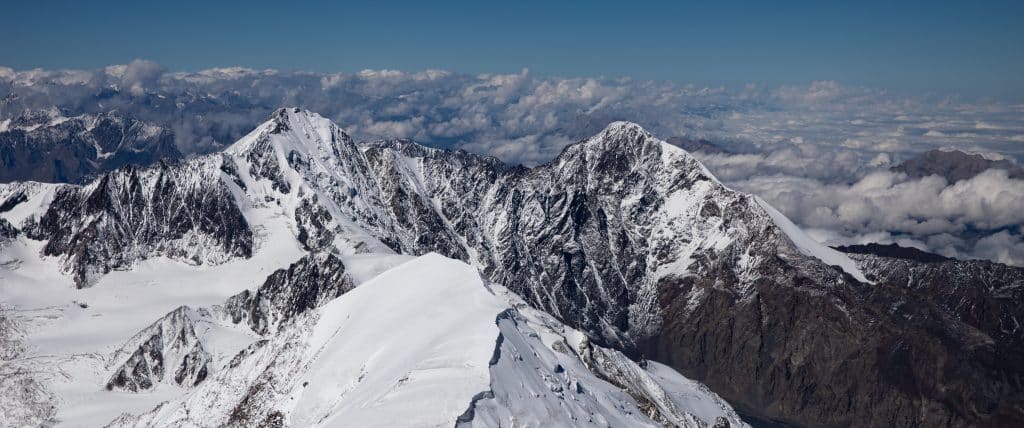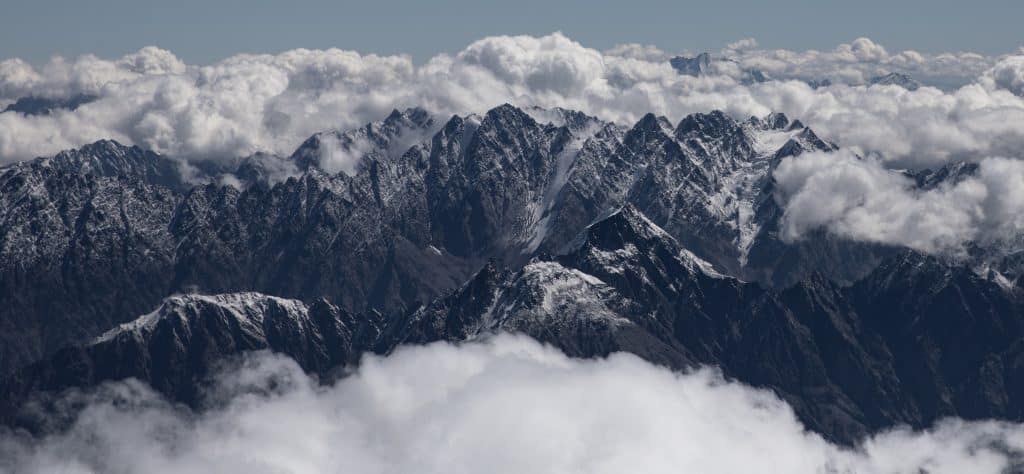Since I wrote about the fascination of mountains in my previous blog post, it makes sense to tie in thematically and also write about a very special mountain. The Kazbek was already mentioned in Greek mythology and supposed to seal the fate of the Titan Prometheus for eternity.
In 2018, I was allowed to have my very own experience with this 5000-meter-high, icy beast, which I could still feel in my own body half a year later. The Kazbek has truly left its mark.
Between the Caspian and Black Seas, the Caucasus mountain range stretches across the national borders of Russia, Georgia, Armenia, Azerbaijan and Iran. Its highest point is the peak of Mount Elbrus in Russia, 5642 meters above sea level. In the northern part, the so-called Great Caucasus on Georgian territory, you can find the 5033 meters high extinct volcano, which is called Qasbegi, or Mqinvartsveri by the local people. Translated, it means “the one covered by ice”. Like a sentinel, its white-covered crest looms over the village of Stepanzminda and the surrounding region.
Mqinvartsveri – The one covered by ice
In Greek mythology we humans are the fosterlings of the Titan Prometheus. During an animal sacrifice he outwitted Zeus, the father of the gods, and leaves him only the worthless parts of the animal, while keeping the good meat for us humans. Completely enraged, Zeus took the fire from man as punishment. When Prometheus then stole the fire from the gods and returned it to the humans, Zeus had the Titan forged to a mountain in the solitude of the Caucasus.
According to mythology, this mountain was the Kazbek. Every day an eagle passed by and feasted on Prometheus’ liver, which regenerated again and again until Heracles finally freed him from his torment. Even today, the Kazbek and its outlets are a sacred place and associated with religious history. The Ossetians, who live in the Caucasus, still call the mountain “Zeristi Jub”, which translates as Christ Mountain Peak. At its feet stands the Gergeti Trinity Church, which is a popular destination and place of worship.
Even before I left, I had made a heated decision to climb this mountain. My romantic idea was to really immerse myself in nature, to get to know a hidden world full of snow, ice and craggy rock, and to look out over the peaks of the Great Caucasus. I had no idea what that meant in reality.


Georgia – A country full of adventures
It is just under 4 hours of adventurous driving from the capital Tbilisi to Stepanzminda. If you have ever taken a cab or a marshrutka – the local minibuses – in Georgia, nothing can upset you. Even the traffic in Hanoi cannot be compared. With dizzying speeds and packed to the brim, these mostly aging minibuses shoot like torpedoes across the country. It sometimes happens that one squeezes into a Ford Transit with 21 other people. A two-lane road is basically made into 3, which can get really exciting during regular overtaking maneuvers. Every time cattle or dogs run into the road, your pulse really shoots up again, especially when a massive truck is heading towards you in oncoming traffic during a mandatory overtaking. After each ride, I felt like I aged years.
Autumn slowly took hold in much of the Caucasus, dropping temperatures to double-digit below zero at higher elevations. This resulted in a lot of fresh snow, both covering crevasses and settling on frozen ice slopes. When the snow starts to melt, it slides away like a board on the underlying ice layer and can lead to huge avalanches.
Afterwards I often heard that Georgian mountain guides are very reticent. I can only confirm this. Once I was equipped by my agency, I met my Russian expedition members and our two mountain guides. There was a sparse briefing and off we went. We drove up to the Gergetier Trinity Church in the early morning by off-road vehicle. By now, a road has been built here to make it easier for tourists to get up to the church. The way takes about 2 hours on foot and goes steeply uphill. What this measure does to the landscape, this picture illustrates quite well.


A completely different world
Already during the ascent to the glacier tongue of Moun Kazbek, the weather showed its most various side. The path meandered over gentle greenery up the steep hills to the tree line. At first, there was only a strong wind blowing with all its might in our way. After a while, however, the wind allied itself with a heavy downpour and, higher up, finally began to throw frozen ice at us. Within seconds, the weather can change and become a sudden challenge. Up to here, however, I was still quite passably equipped, which didn’t change the fact that I was starting to get a little nervous.
Along the lower glacier it went relatively manageable up to a scree field that marked the last ascent to the glacier moraine, on which an old weather station marked the base camp. In the meantime, the hailstorm had turned into a full-blown blizzard that steadily increased in speed over the next 16 hours and to which one or the other tent was to fall victim. A threatening roar was in the air and the sheer force of the wind tugging at you made me flee, intimidated, into the weather station once I reached the top. For the first time I realized what I was getting myself into.


The blizzard blew with incredible speeds over the glacier moraine on which the old weather station was built. For those who want to be self-sufficient, there is the classic base camp with relatively little garbage and excrement right next door. It is impressive to watch this small village of tents among rocks, ice and snow fighting against being swept away by the powerful gusts of wind. The air was full of snow, limiting visibility tremendously. The mountain guides put us up in one of the bunkhouses in the weather station, for which I am quite grateful in retrospect. It was too early for this experience at that time.
For the next 2 days we waited for permission from the mountain to climb it and spent the mornings acclimatizing. In fact, the icy giant was merciful and so we continued up the glacier tongue at 2:00 in the morning in all mountaineering manner. Dozens of headlamps formed a chain of lights in the distance, pointing the way in the dark. We reached the glacier ridge just in time for sunrise, put on our crampons and went into the ropes. The air was already very thin beyond 4200 meters, yet I felt good and was euphoric. The golden light of sunrise illuminated the world that lay at our feet. We already had 4 hours of ascent behind us and another 4 hours to the summit.

You have only made it when you reach the bottom again
Because of the fresh snow we reached a place where the track was already snowed in again. Our mountain guide groped his way forward step by step, keeping an eye for hidden crevasses. Half an hour later, we entered the western shoulder of the mountain, which led to the lower summit plateau with about 45° of ascent. The wind was whipping around with sub-zero temperatures and for quite some time my hands had been hurting from the cold, but I had ignored the pain so far. In the meantime, however, I could hardly grip and when I took off my gloves, I saw why. The sweat had frozen in the glove on my skin and slowly colored my hands blue. I was given two heat pads and after a few minutes my hands were filled with life again. The returning feeling, however, was accompanied by pain, as if thousands of needles were stuck in my hands.
The high snow on the steep slope provided good grip, but had the disadvantage of slipping away, so that we had to overcome small heights in places. At this altitude, every step is difficult, and climbing up through the deep snow was a heavy effort. Halfway up, my original rope team was broken up because both mountain guides who were standing by us had to lead someone back down out of necessity. I had the chance to join another 2-person rope team or the option to turn back. Stubborn and naive, I was determined to prove to myself that I could reach the summit. Bundling all my strength, I entered the summit of Mount Kazbek from the Russian side at 10:20 am.
However, I did not have much time to rejoice. Gasping for air and completely befuddled by the altitude and effort, I tried to take a few photos from the summit when we already had to descend again. The weather indicated a change and clouds slowly filled the valleys. I was exhausted as hell and the descent over the deep snow passage robbed me of what felt like the last of my strength. As soon as we arrived on the glacier ridge, we were in total whiteout. All footprints had disappeared and after only 5 minutes it was actually impossible to tell from which direction we had come or where we were going. Neither could we see where the crevasses were. To this day it is a mystery to me how the other two in my rope team found their way.
The most important muscle in climbing is the brain – Wolfgang Güllich
From sheer exhaustion, I kept losing my footing in the rocky terrain and slipping on snow or icy patches. Getting up again each time required all my strength. Eating or drinking to replenish my energy reserves was almost impossible. I simply could not swallow anything because my body refused to follow its natural functions. My throat was like sealed. With every break, my limbs just wanted to rest. Slowly I was overcome by a terrible tiredness, very similar to the feeling of drunkenness. With all my will I had to fight against falling asleep. I probably was never going to be woken up again. The freezing sub-zero temperatures suddenly didn’t matter; my body was already chilled out anyway. “So this is what it feels like to freeze to death?!”, I thought to myself before getting up in frustration and continuing to descent. All I wanted was to sleep!
An ascent and descent of 1350 vertical meters each through deep snow really has it all! It is obvious that I would never have a chance to survive alone in this cold, white world. Without the experienced rope team I would have been lost. The Kazbek allowed me to climb on its frosty head, but did not let me go without first teaching me a lesson for life. The nerves in my left big toe partially died, so for a little over half a year I felt a tingling sensation and had little feeling in my toe.
Even more deeply, however, this experience has etched itself into my memory and demonstrated yet another time the value of life. You may not be out on your own, but you make a decision for yourself alone and have to deal with the consequences. When you visit Mother Nature’s playground, you need a strong will and stamina. You will be most judicially faced with the choice of whether to go to sleep and possibly close your eyes forever, or to choose life.


